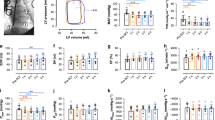Abstract
Purpose
This study aimed to determine whether the combination of H2 gas inhalation and administration of hydrogen-rich acetated Ringer’s solution (HS) could protect against ischemic spinal cord injury in rabbits.
Methods
In Experiment 1, rabbits were randomly assigned to a 1.2% H2 gas group, HS group, 1.2% H2 gas + HS group (combination group), or control group (n = 6 per group). The H2 concentration of HS was 0.65 mM. H2 was inhaled for 60 min, starting 5 min before reperfusion. HS (20 mL/kg) was divided into six bolus injections at 10-min intervals, starting 5 min before reperfusion. Spinal cord ischemia was produced by occluding the abdominal aorta for 15 min. Neurologic and histopathologic evaluations were performed 7 days after reperfusion. In Experiment 2, H2 concentrations in spinal cord tissue according to the administration of 1.2% H2 gas or HS were compared by measuring the electric current through a platinum needle electrode (n = 2). In Experiment 3, rabbits were assigned to a 2% H2 gas group or control group (n = 6 per group). Spinal cord ischemia was produced and neurologic and histopathologic evaluations were performed as in Experiment 1.
Results
There were no significant differences among the groups in the neurologic and histopathologic outcomes in Experiments 1 and 3. Bolus administration of HS (10 mL) transiently increased the current to only 1/30th and 1/27th of the plateau current with 1.2% H2 gas inhalation in two animals.
Conclusion
These results suggest that the combination of 1.2% H2 gas inhalation and administration of a hydrogen-rich solution does not protect against ischemic spinal cord injury and that the increase in H2 concentration in spinal cord tissue after administration of HS is very low compared to 1.2% H2 gas inhalation.






Similar content being viewed by others
Data availability
Data used in this paper may be submitted upon request.
References
Ohsawa I, Ishikawa M, Takahashi K, Watanabe M, Nishimaki K, Yamagata K, Katsura K, Katayama Y, Asoh S, Ohta S. Hydrogen acts as a therapeutic antioxidant by selectively reducing cytotoxic oxygen radicals. Nat Med. 2007;13(6):688–94.
Ichihara M, Sobue S, Ito M, Ito M, Hirayama M, Ohno K. Beneficial biological effects and the underlying mechanisms of molecular hydrogen – comprehensive review of 321 original articles. Med Gas Res. 2015;5:12.
Huang Y, Xie K, Li J, Xu N, Gong G, Wang G, Yu Y, Dong H, Xiong L. Beneficial effects of hydrogen gas against spinal cord ischemia-reperfusion injury in rabbits. Brain Res. 2011;1378:125–36.
Zhou L, Wang X, Xue W, Xie K, Huang Y, Chen H, Gong G, Zeng Y. Beneficial effects of hydrogen-rich saline against spinal cord ischemia-reperfusion injury in rabbits. Brain Res. 2013;1517:150–60.
Kimura A, Suehiro K, Mukai A, Fujimoto Y, Funao T, Yamada T, Mori T. Protective effects of hydrogen gas against spinal cord ischemia-reperfusion injury. J Thorac Cardiovasc Surg. 2022;164(6):e269–83.
Utada K, Ishida K, Tohyama S, Urushima Y, Mizukami Y, Yamashita A, Uchida M, Matsumoto M. The combination of insulin-like growth factor 1 and erythropoietin protects against ischemic spinal cord injury in rabbits. J Anesth. 2015;29(5):741–8.
Fukui T, Ishida K, Mizukami Y, Shiramoto K, Harada H, Yamashita A, Yamashita S, Matsumoto M. Comparison of the protective effects of direct ischemic preconditioning and remote ischemic preconditioning in a rabbit model of transient spinal cord ischemia. J Anesth. 2018;32(1):3–14.
Matsumoto M, Iida Y, Sakabe T, Sano T, Ishikawa T, Nakakimura K. Mild and moderate hypothermia provide better protection than a burst-suppression dose of thiopental against ischemic spinal cord injury in rabbits. Anesthesiology. 1997;86(5):1120–7.
Drummond JC, Moore SS. The influence of dextrose administration on neurologic outcome after temporary spinal cord ischemia in the rabbit. Anesthesiology. 1989;70:64–70.
Ono H, Nishijima Y, Adachi N, Sakamoto M, Kudo Y, Nakazawa J, Kaneko K, Nakao A. Hydrogen(H2) treatment for acute erythematous skin diseases. A report of 4 patients with safety data and a non-controlled feasibility study with H2 concentration measurement on two volunteers. Med Gas Res. 2012;2(1):14.
Funding
This study was partly supported by a grant for developing hydrogen engineering applications in medical and health care from Yamaguchi Prefecture.
Author information
Authors and Affiliations
Corresponding author
Ethics declarations
Conflict of interest
The authors declare no conflict of interest.
Additional information
Publisher's Note
Springer Nature remains neutral with regard to jurisdictional claims in published maps and institutional affiliations.
About this article
Cite this article
Yamashita, A., Fukui, T., Yamashita, S. et al. The combination of hydrogen gas and hydrogen-rich solution does not protect against ischemic spinal cord injury in rabbits. J Anesth (2024). https://doi.org/10.1007/s00540-024-03334-4
Received:
Accepted:
Published:
DOI: https://doi.org/10.1007/s00540-024-03334-4




